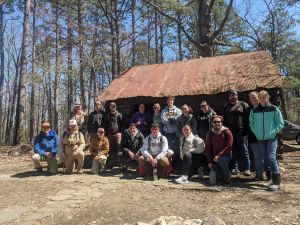Name
MOFEP Small Mammal Publications
List of publications from the MOFEP small mammal project
In project: Small Mammals
MOFEP Tours and Field Experiences
Learn more about our MOFEP tours and field experiences! See photos from previous group trips.
Name
MOFEP: A 100-Year Forestry Study
Missouri Conservationist Article by Elizabeth Olson.
Name
MOFEP: site history, soils, landforms, woody and herbaceous vegetation, down wood, and inventory methods for the landscape experiment
Published on Aug 31, 2000
Name
National Survey of Fishing, Hunting, and Wildlife-Associated Recreation reports
Reports from the National Survey of Fishing, Hunting, and Wildlife-Associated Recreation are available from the United States Fish and Wildlife Service.
Name
Proceedings of the Missouri Ozark Forest Ecosystem Project Symposium: an experimental approach to landscape research
Published on Nov 20, 1997
Name
Proceedings of the second Missouri Ozark Forest Ecosystem Project Symposium: Post-treatment results of the landscape experiment
Published on Oct 17, 2000
Name
Publications related to the Missouri black bear research project
Publication citations that resulted from data collected during various stages of the Missouri Black Bear Project.
In project: Missouri Black Bear Project
Name
qryPastPricesForResearchWeb20250102.csv
Missouri Timber Price Trends (all price from 1994 to the present)
In project: Forest Economics in Missouri
Name
Reducing Neonicotinoids in Aquatic Resources: Vegetative Buffer Strips impede imidaclorprid movement in Missouri agroecosystems
Neonicotinoids are a class of broad-spectrum systemic insecticides frequently used in agroecosystems to control root and leaf eating pests. The widespread use and environmental persistence of neonicotinoids in the U.S. and globally has resulted in surface water contamination and build-up of neonicotinoids within other environmental sectors, such as soils and wetlands. Deleterious effects of neonicotinoids on non-target insects and wildlife heightens the need to determine practices that reduce potential for these chemicals to reach aquatic ecosystems through subsurface connections and overland surface runoff. An understanding of neonicotinoid sorption (any removal of a compound from solution to a solid phase) and transport in soil is critical for determining and mitigating environmental risks associated with this class of insecticides. We evaluated whether conservation practices, such as vegetated buffer strips (VBS), could reduce neonicotinoid entry into surface waters and aquatic ecosystems. One of the most commonly used neonicotinoids is imidacloprid (ICD) which first entered the United States markets in 1994. This Science Note focuses on differences in the sorption and transport of imidacloprid within soils collected from grass VBS, riparian VBS, and agricultural fields planted to corn/soybean.
